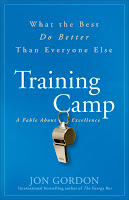 The following comes from Jon Gordon's fabulous book, "Training Camp."
The following comes from Jon Gordon's fabulous book, "Training Camp."As part of my preparation I interviewed the top sales people from the financial services company and while I was expecting to hear some new sales techniques that I haven’t heard before I discovered there wasn’t any secret formula to their success. They told me they simply worked hard, focused on the fundamentals, stayed positive and had a great desire to succeed and make an impact. It was the same things I had heard from the best professional athletes I knew and from all the people I had interviewed over the years that were considered the best in their field.
..................
I’ve found that the first and foremost trait of the best of the best is that they know what they truly want.
1. The Best know what they truly want.
For many who strive to be the best, there was a person before them who paved the way, who showed them that greatness was possible. Sometimes this person was a friend or mentor, and other cases it was a complete stranger who showed the world what being the best looked like.
....................
“Then there were those who were simply settling for mediocrity. They created a nice, average life with something they were average or good at, with a feeling in their gut that there is something more—something missing in their life—something that was left unsaid and undone. They wrote down goals because people said you need to do that, and yet the goals had nothing to do with what they truly wanted. They knew there was more, and thankfully one day they found it. But the common thread between all these stories and people is this: Regardless of when and how, whether by practical experience, role model, spiritual insight, or lightening strike, the best of the best all had a moment in their lives when their vision became clear.
“Then there were those who were simply settling for mediocrity. They created a nice, average life with something they were average or good at, with a feeling in their gut that there is something more—something missing in their life—something that was left unsaid and undone. They wrote down goals because people said you need to do that, and yet the goals had nothing to do with what they truly wanted. They knew there was more, and thankfully one day they found it. But the common thread between all these stories and people is this: Regardless of when and how, whether by practical experience, role model, spiritual insight, or lightening strike, the best of the best all had a moment in their lives when their vision became clear.
..........................
When they said, this is what I truly want. This is what I want to strive for and I will pay the price to make it happen. It was as if they looked through a telescope and saw their future.
“Seeing it is important because to reach your destination you know you have to travel through the valley of hardship and struggle to get there. But your big-picture vision will fuel you during your journey and help you near the struggle and overcome the hardship to reach your goal.”
“If you don’t know what you want, then you won’t have a passion for it and you won’t strive to be great at it. You’ll be like 90 percent of the world’s population who are either doing something they are good at or just collecting a paycheck. But whatever you do, don’t be a 50 percenter. Invest 100 percent and every ounce of your energy in knowing what you want and becoming great at it. Strive to be your best and stand tall.”
2. The Best want it more.
“The answer is that we can’t measure desire in terms of merely thought and wishes. After all, someone could wish for something twelve hours a day, but if they aren’t taking initiative to make it happen, then what good is all the wanting? We must also measure desire in terms of actions, too. The best of the best are willing to do what it takes to be great. The best don’t just think about their desire for greatness, they act on it.”
To deny being your best was to deny the gift you were meant to give others.
“So, the best take action that demonstrates their greater desire. The best not only do the things that other won’t do and invest the time others won’t invest, but they also do so with passion and the intent to get better. The best are never satisfied with where they are. The third trait of the best is that they are always striving to get better.”
3. The Best are always striving to get better.
“Of course, those are essential, but what it really requires is a willingness to be uncomfortable. Here’s the deal. If you are always striving to get better, then you are always growing. And if you are growing, then you are not comfortable. To be the best, you have to be willing to be uncomfortable and embrace it as part of your growth process. It’s a process, and I’m going to tell you how it works.”









 Today on the LSU campus, three of our managers will walk across the stage of the
Today on the LSU campus, three of our managers will walk across the stage of the





















